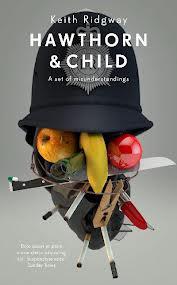 I need to tell you something right up front – I don’t think any review can really do this book justice. It’s the impossibility of the task that makes me even willing to attempt it, and if that makes no sense, welcome to the strange world of North London detectives Hawthorn & Child.
I need to tell you something right up front – I don’t think any review can really do this book justice. It’s the impossibility of the task that makes me even willing to attempt it, and if that makes no sense, welcome to the strange world of North London detectives Hawthorn & Child.
Keith Ridgway is a Dublin author with three previous novels and various literary prizes to his name and he lived in my part of North London for 12 years. In his Twitter profile he says, ‘Queer Irish writers are two a penny but I cost a pound.’ Two things about that: he is worth it (and considerably more), and people who write like him aren’t two a penny at all. I’ve never read anything quite like this book. Several people have asked me for recommendations lately saying it’s been a while since they read anything really exciting and different. If you’re in that kind of rut, I can think of nothing more likely to blast you out of it than Hawthorn & Child, and doubly so if you have scruples about swearing, sex, religion or violence (only one of those applies to me, and I got over it.)
So is this a detective novel? Certainly not in the usual sense. If the popularity of crime fiction lies in the sense of resolution, of order being restored at the end, H&C emphatically doesn’t do that. I’m not sure it’s even a novel; it’s eight interlinked stories (two of which were published in earlier versions in The New Yorker). The closest it gets to classic detective fiction is in the opening story in which mid-ranking detectives Hawthorn and Child are sent to investigate the dawn shooting of a young banker whose only memory is of a mysterious vintage car. But when each story ends, unresolved, the next starts out of nowhere without the reader knowing who the narrator is, connections taking some time to become apparent. The two detectives come and go, not always as protagonists, and the overall effect is disorienting. You need to stay on your guard.
I’m generally wary of back of book blurbs but this one does a good job, talking of an eclectic cast of characters who battle with a world that is sometimes sinister, sometimes comic, but always perplexing and absurd. I doubt that many readers would consider difficulty following what’s going on as plus point, but once I accepted that as part of the deal, it was a strangely liberating experience; some things became clear, a lot didn’t. When a key piece of information fell into place, I often found myself returning to the beginning of that section and when, without intending to, I re-read much of the book whilst writing this, I saw many things I’d missed the first time. There was a lot of saying ‘Now I get it’ into thin air.
I loved the deliciously tongue-in-cheek moment Ridgway allows himself in the tale of the psychopathic book editor when he says (apropos of a manuscript he’s reading) It leaps both logically and chronologically, from one absurd set-up to the next. As a writer I am utterly in awe of the way Ridgway sticks his finger up to so many of the rules and gets away with it, and this got me thinking about how he does that. Three key strengths to Hawthorn & Child grant him the latitude to experiment in other areas. His rendering of place and the way he lends significance to tiny mundanities of city life:
His [Hawthorn’s] head naturally turned towards the ground. He looked at the little bit of London at his feet, at the smudges and marks, the scuffs and scratches, the tiny scraps of paper stuck to the stone. Tiredness allowed everything to flow into everything else.
He has a very vivid touch which brings certain characters off the page even though they only figure briefly, from a ‘normal’ teenage girl to a mentally-ill man obsessed with Tony Blair to a religious fanatic – the creepier the better. However, his triumph of characterisation is Hawthorn – vulnerable, angst-ridden, prone to fits of weeping and partial to anonymous sexual encounters. Not a very impressive detective (Child is much better able to keep his mind on the job), Hawthorn is both contradictory and fascinating and I wish there’d been more of him.
This brings me to the reason any of this works: Ridgway’s writing. It’s blunt, tense, exciting. It doesn’t flow. It is arrestingly different. There are some superb individual lines – here’s the one which made me want to read the book in the first place, on a favorite subject of mine:
Random is never really random.
And how about this, from the editor character?
I am almost unspeakably bored with every aspect of my life. (which leads him to a disturbing choice of hobby.)
The conscious risk-taking in Hawthorn & Child makes it feel redundant to talk about things that didn’t work for me, but for what it’s worth, I found the constant jokes about Child’s name tedious and in the last few stories there were some incidents that I found really twisted and gratuitous, trying too hard to shock. I must have been expecting the narrative to come full circle and return to the original case, and because that didn’t happen, I found the ending a bit of an anti-climax.
Maybe it was explained. Maybe I missed it. To quote again from the back cover:
The only certainty is that we’ve misunderstood everything.
Have you read anything which breaks the rules?

